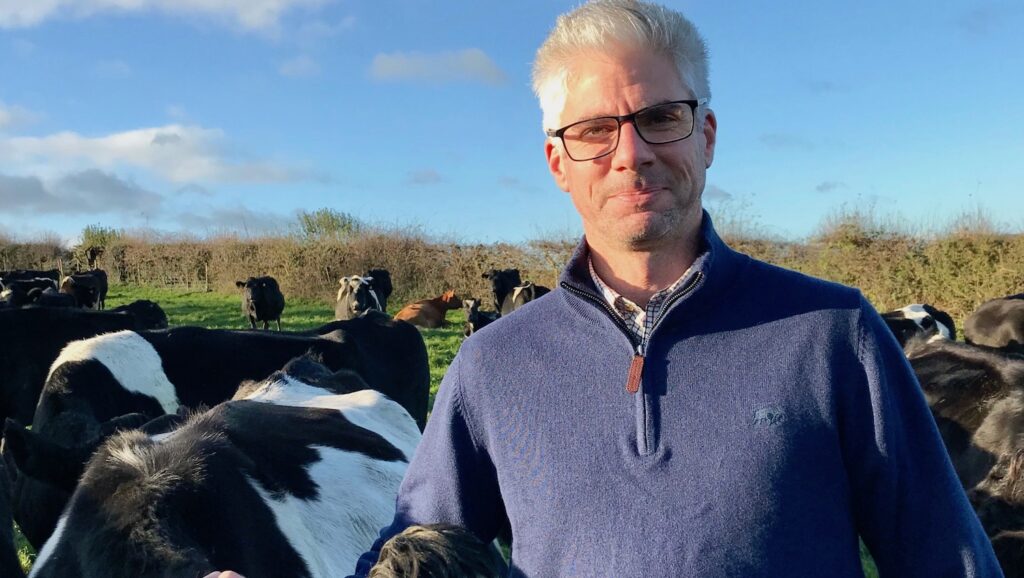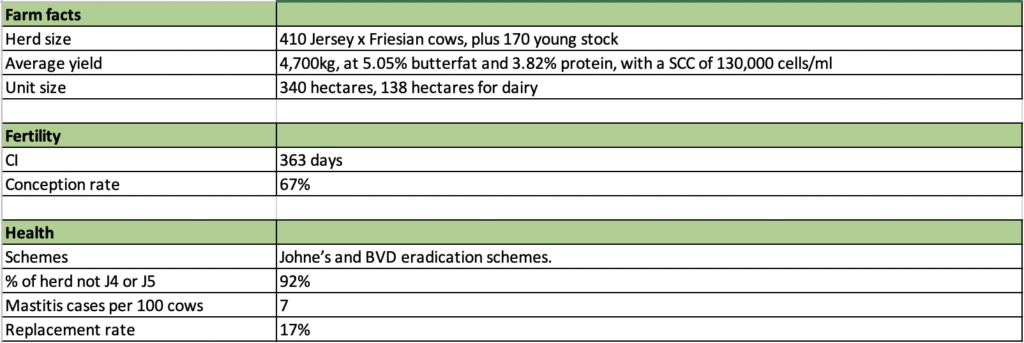Grass-based system going for gold
8th December 2020
Salisbury farmer Mark Hoskins is one of six dairy businesses in the running for the 2020 NMR/RABDF Gold Cup. Farmers Guide finds out more.
Mark Hoskins from Down Dairy Farm, Hindon, Salisbury says he was thrilled to discover his herd had made it through to the final six dairy businesses, all vying for the 2020 NMR/RABDF Gold Cup. “It’s the first time we’ve entered and just to make it this far is a real achievement,” he says.
His decade-old business has caught this year’s judges’ eyes, not least due to the impressive fertility and efficient milk production of this spring calving, grass-based herd.
Mark runs a contract farming business, based at Hindon near Salisbury, and is currently milking 410 Friesian x Jersey dairy cows, plus 170 followers, on a platform of 138 hectares.
A blueprint for new entrants
The business, a limited company with two equal partners, was set up on what Mark describes as a meagre budget. “It stands on its own two feet, claiming no subsidies while still making a healthy profit,” he says. “When benchmarked against similar systems, we are always in the top 5 per cent,” he says, adding that he has set up a low-cost business model that is sustainable and easy to repeat year in, year out.
“I believe that prospective new entrants could, feasibly, follow this blue print.”
The herd’s tight 12-week calving block starts on February 1st. Cows are milked twice-a-day, through the unit’s 32:64 Fullwood herringbone parlour, which has a throughput of 200 cows per hour. The herd’s average yield stands at 4,600 litres, at 5.05 per cent butterfat and 3.82 per cent protein, with a SCC of 130,000 cells/ml. Milk from forage stands at an impressive 4,257 litres (92.5%) and bought-in feed cost for the qualifying year were just 1.3ppl.
The herd is managed on an all-grass system, targeting 14 tonnes of grass growth to the hectare. Grazed grass makes up the majority of the cows’ diet, minimal concentrates are fed through the summer, with 3kg fed on the shoulders, with silage, to extend the grazing rotation in the spring and autumn.
“Growing grass and utilising it are fundamental to our business,” says Mark. “Grass growth is measured weekly. Soil samples and leaf tissue samples are taken regularly with help from our FACTS registered agronomist. Soil health is also key to our success.”
Improving resilience
In 2016, he reduced the stocking rate from four to three cows per hectare. This optimised the unit’s CSR (comparable stocking rate) by managing growth versus cow demand, making the business more resilient, according to Mark.
“We’re currently trialling herbal leys, for their drought resistance and anthelmintic properties. And a deal has just been finalised with an arable neighbour to buy standing straw, export FYM, sow Westerwolds and graze young stock through the winter months on his land.
“This reduces our housing costs and provides him with a second income stream while, at the same time, enhancing his soil indices.”
He says that, husbandry aside, a significant part of his job is business management. “After the cows have been milked and the staff have gone home, my brain is still ticking. I’m looking to the next job, making sure it is viable and how it can be efficiently executed. I spend a lot of time considering how the business can evolve. I have thought about once-a-day milking and organic farming.”
Maximising the milk contract
Breeding is also key to the unit’s success. “We AI our cows to the best grazing genetics available for the first six weeks, breeding animals with plenty of capacity for forage and that produce high fat and protein components,” explains Mark.
“This allows us to maximise our milk contract. Blackmore Vale Dairy pays us for fat and protein, with added bonuses. It suits our Friesian x Jersey herd.”
Breeding also puts high emphasis on feet, legs and udders. Bulls are run with the herd in rotation for the remaining six weeks. Black-and-white cows are bred to Jersey and vice versa for hybrid vigour.”
As grazing animals, their yields are not as high as pure Holsteins, but a plus is that this lowers mastitis levels. Cow are checked daily during milking for mastitis and good coverage of teat spray is applied post milking.
Lame cows are pulled out of the main group, treated immediately and kept in a hospital group until sound on their feet again. The Jersey crosses have far fewer lameness issues due to having hard, black feet.
Look out for more articles on the six dairy businesses that are up for the 2020 NMR/RABDF Gold Cup – Farmers Guide will be publishing a profile on each in the run up to Dairy Tech Online in February.


